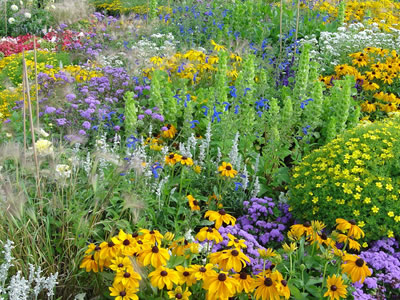 by Peter Fuller by Peter Fuller
When I first moved to the three acres which would eventually become my native plant nursery, it was not much more than a farm field that had been ignored for many years. Wet spots made planting and harvesting awkward. Although there were plants, birds and insects, I felt that this land lacked something that I had difficulty putting into words. I enjoy detail and complexity for their own sake, but the field felt impoverished because it was not very productive in terms of agricultural food production. The entire network of organisms had been depleted and suppressed.
Over the next several years, I planted hundreds of trees, created seasonal ponds in the wet areas, introduced an area of granite boulders taken from old fence rows to build a rock garden, planted a naturalized buffer zone between the nursery and nearby farm fields, made compost and filled beds with native perennials, grasses and shrubs. I grew as many things as possible from local seed sources.
Changes occurred faster than I had anticipated. I remember one day when I noticed that there seemed to be a great number of many species of dragonflies flying around, and the ponds were surrounded by plants that had naturally seeded themselves. Other obvious newcomers were frogs in the ponds, turtles on the lawn, mallards nesting nearby, snakes in the rock garden, birds visiting during spring and fall migrations and butterflies in the gardens. The colorful perennials had all started to bloom. Year after year, the number and variety of organisms continued to expand. The land was experiencing a rapid growth in biodiversity.
Biodiversity encompases the variation among and within populations in an interconnected web of organisms. It includes not only the relationships easily seen among plants and animals but also those involving fungi, soil organisms and bacteria. And it pays special attention to the genetic diversity within a given population.
Why does biodiversity matter to a gardener? Besides the aesthetic considerations of varieties within a landscape, the very existence of life depends on biodiversity. Of greatest interest to gardeners is the idea that biodiversity provides balance and resilience.
In any complex network or system, the number of participants and the multiple paths they can follow to achieve what they need (for example, food, shelter, reproduction) provide checks and balances to the whole system so that extremes are avoided. High biodiversity provides this naturally balanced environment.
As an illustration of this, I am reminded of something that occured in my nursery. One day, I found several pots of Penstemon seedlings covered with aphids. Despite resolving to do something about this, I only returned several days later, as I was swamped by other tasks. The trays were in the nursery with hundreds of other species and accessible to all types of flying insects. When I examined the plants the second time, there were hoverfly larvae (Syrphidae) all over these leaves gobbling up the aphids, and when I finally had time to take action a few days after that, the apparent crisis was over and there was nothing for me to do. Growing the plants within a diversified environment had let the ecosystem balance the situation. This does not mean intervention is never required. Gardens by their very nature are somewhat artificial, but the more biodiverse a system is, the more ways there are for it to balance itself.
Changes to climate patterns are of special concern because they require adaptation by all organisms. Future conditions may be very different and unpredictable. Within any given population, genetic diversity means that certain individuals will be able to adapt better, so having a high degree of diversity at the outset means the web is more resilient in the long term.
The easiest way for gardeners to participate in increasing this resilience is to grow plants from seed and to grow those plants that interact in interdependent ways with soil organisms, insects, birds, and animals.
My special area of interest has been promoting the use of native plants in garden settings, since they are so well suited to fitting into the web of organisms in any given area. I limit the use of cultivars in my garden and I keep starting plants from seed, even when vegetative division (cutting or splitting) is easy, so that genetic diversity is constantly encouraged.
Whenever possible I use locally collected seeds. I have developed a network of neighbours with woodlots, fields and wetlands where I can collect seed to establish stock plants in the nursery’s gardens. I practise ethical seed collection by obtaining permission from property owners, and I never collect seed from rare or endangered plant populations and I only take a maximum of 10% of the existing seed. Collecting from different individuals provides genetic diversity among the next generation of plants.
Much of the seed from my local flora in eastern Ontario needs a cold/moist period to break seed dormancy. I sow seeds in sheltered places in pots that are sunk in the ground and mulched with leaves. I put most pots into plastic bags to retain moisture, but pots of shrub/tree seeds can attract rodents, so I use a covering of hardware cloth for these or place them in an unheated building. Pots in bags must not be in direct sunlight and the bags must be removed in the spring. The seeds can be placed in the fridge in damp vermiculite for a few months using resealable plastic bags.
My seed collecting starts in the spring as the woodland bursts into a frenzy of blooming before the canopy closes over. Most of these spring flowers (Trillium, Bloodroot, Hepatica, Wild Ginger, etc.) produce abundant seed but they are moist and cannot be allowed to dry out. I watch for pods and fruits starting to break open. I store the cleaned seeds immediately in damp vermiculite in resealable plastic bags in a dark place, such as a cool cupboard. Starting in November, I provide the seeds with a cold and moist period (outside during the winter in pots or a garden bed is best, but inside a fridge is an alternative).
Many of the meadow and wetland plants produce dry seed heads, which turn brown when ready and stay on the plant for some time. I clean and store these dry until I sow them in November. Fleshy fruits, such as those of elder, raspberries, dogwood, and viburnum, can be easily extracted by mashing the fruit inside a plastic bag and then washing the contents using a sieve. I do not allow nuts to dry out. I mix them with damp vermiculite and store the bags either in the fridge or in bins of leaves outside. I shake cones inside a tin to dislodge their seeds. Seeds seem to be everywhere in the autumn, and I spend a number of days collecting, cleaning, labeling and storing them. Frozen wetlands become accessible in the winter allowing for easy seed collection from sedges, wild iris and shrubs.
After a long winter, April is much anticipated. Seed bags come out of the fridge and their contents are sown in pots or in the ground. Inevitably some pots reveal no growth, but I keep them shaded and moist and wait to see if they will produce anything the following spring.
Propagation is one of the most satisfying experiences of gardening and always full of surprises. It may take a year or two to get to know the preferences of a particular species, but seed propagation produces an endless supply of garden plants and brings with it a deeper knowledge and appreciation of the local flora.
Increasing the biodiversity of the landscape around the nursery has greatly improved its productivity in so many ways, not just in terms of food for people. A balanced and resilient network of organisms allows nature to produce all the benefits of a healthy system: soils are fed and improved, matter and energy cycled and water cleaned. Living things in all their diverse forms flourish.
|


![]()

 by Peter Fuller
by Peter Fuller